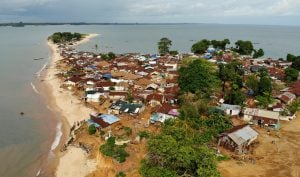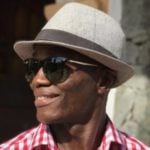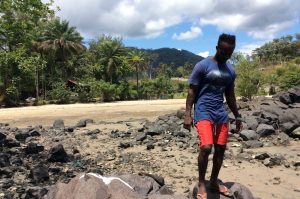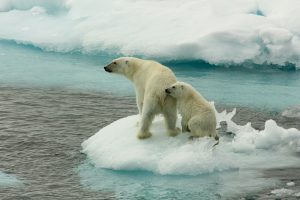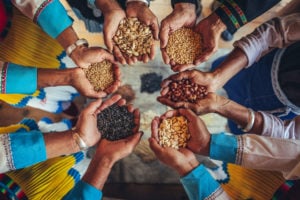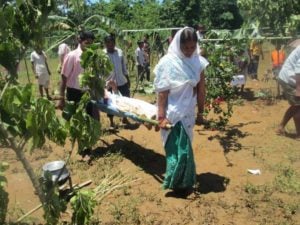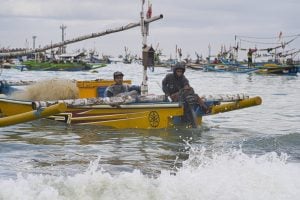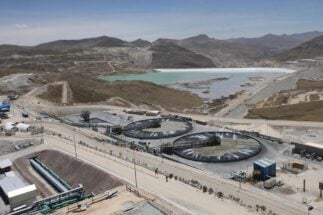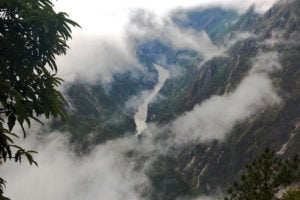Passengers clamber out of a small wooden boat named “God Lek True” (God likes truth), trying to stay dry after an hour-long journey to Bonthe, the main town on Sherbro Island in the south of Sierra Leone. Near the jetty, waves break against a new sea wall – still under construction – that locals hope will protect their island from sinking. All along the West African country’s coast, communities are in peril as rising sea levels, driven by global warming, are submerging houses, farmland and culturally significant sites.
Sierra Leone’s 530km coastline is predominantly low-lying, dotted with beaches and islands. Vast swathes of mangrove forest do provide some protection from the sea. But this vegetation cover, which prevents erosion and acts as a natural barrier against storms, is being removed for firewood and to build new homes. Unregulated sand mining is adding to the problem, making coastal communities increasingly vulnerable to not only rising seas, but also more extreme weather caused by climate change.

These are not problems that belong to Sierra Leone alone. Globally, sea levels are expected to rise between 0.6 and 1.3 metres by the end of the century unless greenhouse gas emissions are curtailed. But in West Africa, around one-third of the population lives in coastal areas, which generate more than half of the region’s GDP. Add to this the high levels of coastal degradation, and rising seas could well have a much bigger impact here than elsewhere, on people and the economy alike.
In 2017, the Intergovernmental Panel on Climate Change ranked Sierra Leone third after Bangladesh and Guinea Bissau on its list of nations most vulnerable to the adverse effects of climate change – despite the country being one of the lowest contributors to global emissions.
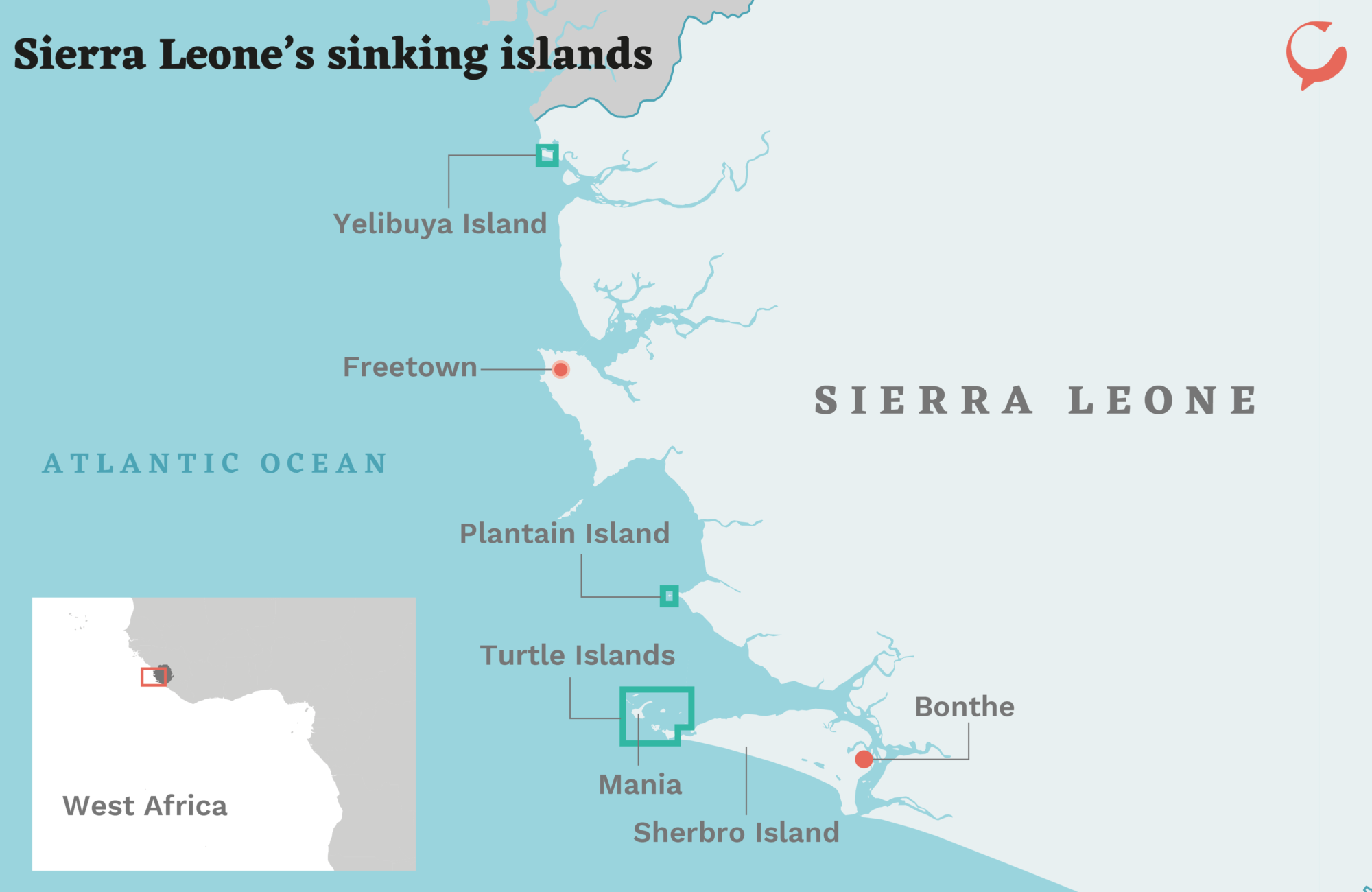
On the Turtle Islands, a small archipelago off the western coast of the larger Sherbro Island, around 500 inhabitants have already relocated further inland after floods repeatedly washed away their homes.
The situation is the same in the north of the country, where 2,000 people from Yelibuya are to be relocated because their island is sinking. In total, more than two million Sierra Leoneans living along the coast are expected to be at risk.
“Houses that were along parts of the coastline some 15-20 years ago have now disappeared into the sea,” says Dr Raymond Johnson of the Institute of Marine Biology and Oceanography at Fourah Bay College.
Erosion is one of the main problems. He warns that the mangroves, which also provide breeding grounds for fish and land for farming, are being depleted without being replaced, at an unsustainable rate. “And if the level of removal of sand [by sand miners] surpasses that of replenishment, this too serves as a precursor for erosion.”
Houses that were along parts of the coastline some 15-20 years ago have now disappeared into the sea
Indiscriminate sand mining along the coast is a lucrative business, and a major source of income for many young people, who struggle to find work elsewhere. Despite its devastating effects, vested interests are hampering efforts to stop it. There are allegations that local chiefs are getting rich by taxing the sand miners, and the problem is further complicated by confusion over who has final authority when it comes to regulating the industry.
Loss of livelihoods
On Plantain Island, home to one of Sierra Leone’s most historic sites, sea-level rise is causing devastation. Where once its inhabitants cultivated crops on nearly eight square kilometres of land, farming activities are no longer possible because most of the land has been lost to the sea. Residents now rely mainly on artisanal fishing.
There is no available government data on the extent of sea-level rise here, but locals estimate the sea has encroached by more than 300 metres over the past four decades. Life on this island is becoming increasingly impossible, residents say. Their community was once buzzing with activity, with traders from the capital Freetown braving the choppy waters in small canoes to buy the island’s fish in exchange for alcohol, clothes, building materials and food. Today, even getting fresh vegetables is difficult, and almost everything, including drinking water, has to be imported from Tombo, a nearby fishing community.

Community chief Gbassay Kabbia says the island was previously home to more than 5,000 people. Today, only 3,000 remain after many have relocated to nearby islands. Kabbia has watched helplessly as the sea swallowed two of his houses.
He and his family have now moved further inland. He gestures towards the wreckage of houses that once stretched along the shoreline, mentioning a 52-year-old woman, Nanday Thollie, as the latest victim of the sea’s destruction. Thollie’s house was built just a few metres from the shore, making it particularly vulnerable to storm surges, where waters rise above their normal levels and are pushed inland by the wind.
(Video: Saidu Bah / China Dialogue Ocean)
Nearly all the houses on Plantain Island have been built with little regard for the long term. “People are supposed to build permanent structures at least 1km away from the sea,” says Gabriel Mannah Kpaka, deputy director general of Sierra Leone’s Meteorological Agency. “But you’ll see that structures are built [within] 100 metres.” Without a sea wall to protect the houses, destruction takes places every time the low-lying community is hit by a storm.
Islands of historical value
Between 1747 and 1807, slave traders bought captives from warring inland tribes to Plantain and the nearby island of Dublin, where they were chained and held for transit to Bunce Island. As many as 60,000 slaves passed through Bunce on their way to the West Indies and America.
The former quarters of the slave merchant, John Plantain, after whom Plantain Island was named, is an important part of this history, and a tourist attraction. It used to be connected to the main island, but over the years the rising saltwater has separated it completely. Local and foreign tourists now have to take a boat to get to the site, but there’s very little left to see, says local resident Ben Caulker.
“If you visit the slave pen, you could see relics of the slave trade. The place used to have guns used during the colonial era. All those have now disappeared,” he says.
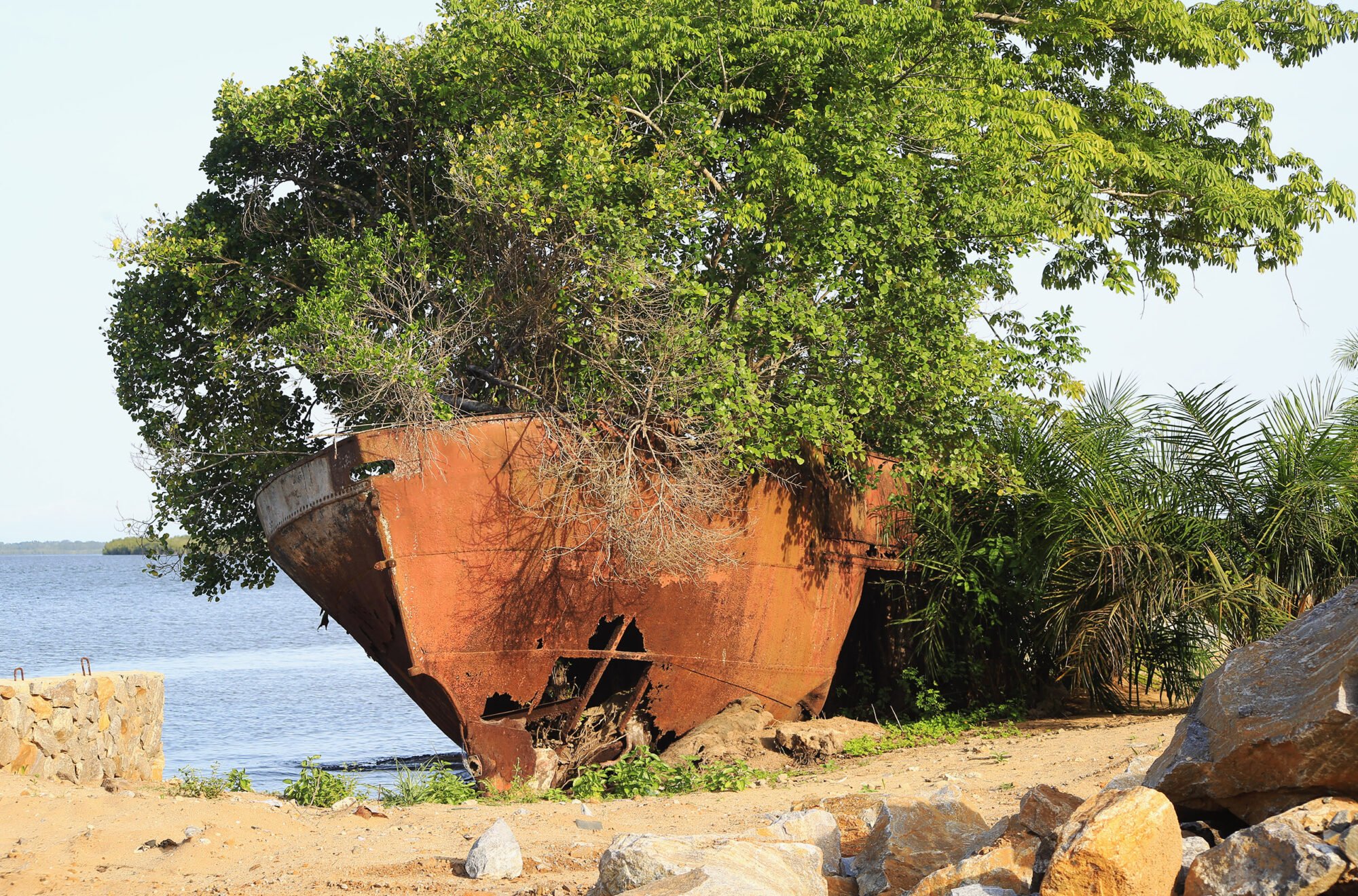
Sierra Leone is not the only country in West Africa losing historical heritage to sea-level rise. To the north in Senegal, the UNESCO World Heritage colonial city of Saint-Louis is losing houses, streets and cropland to the rising saltwater.
West African nations are counting the economic cost of this and other climate change impacts. In 2019, the World Bank found that flooding and coastal erosion due to sea-level rise cost the region around US$3.8 billion and caused the deaths of 13,000 people in just one year.
More than 100 leaders from poorer nations are now demanding richer countries do more to counter global warming ahead of this year’s COP26, the most crucial climate talks since the Paris Agreement was signed in 2015.
Fishing safely
Another group feeling the immediate impacts of the changing climate is Sierra Leone’s fishers. On Mania, one of the Turtle Islands 30 minutes by boat from Bonthe, small-scale fishers are struggling with more extreme weather and the unpredictable movement of fish escaping warming waters. This is being exacerbated by increased competition from industrialised foreign fishing fleets, who leave fewer fish for local people.
The island used to be inhabited by some 500 people, but only 300 residents remain today. Life is tough, says Mania’s youth chairman, Lahai Kain, and many worry about the long-term survival of the community.
(Video: Saidu Bah / China Dialogue Ocean)
Last year, Kain almost lost his life during a fishing trip. His wooden boat was hit by strong waves that left him and his friends stranded at sea. They had to wait hours to be found by a local rescue party, and by then he had lost his boat along with all his fishing gear. He now relies on small-scale farming to feed his wife and three children. He hopes to return to sea very soon, and is saving to buy a new boat. But he wants improved weather forecasts to help fishers like him plan their excursions and improve their productivity.
To this end, Sierra Leone’s Meteorological Agency has installed eight new automatic weather stations in strategic locations around the country, says Deputy Director General Kpaka.
According to Kpaka, these stations are manned by people trained in weather-monitoring systems to provide timely information on offshore conditions so fishers can know when it’s safe to go out.
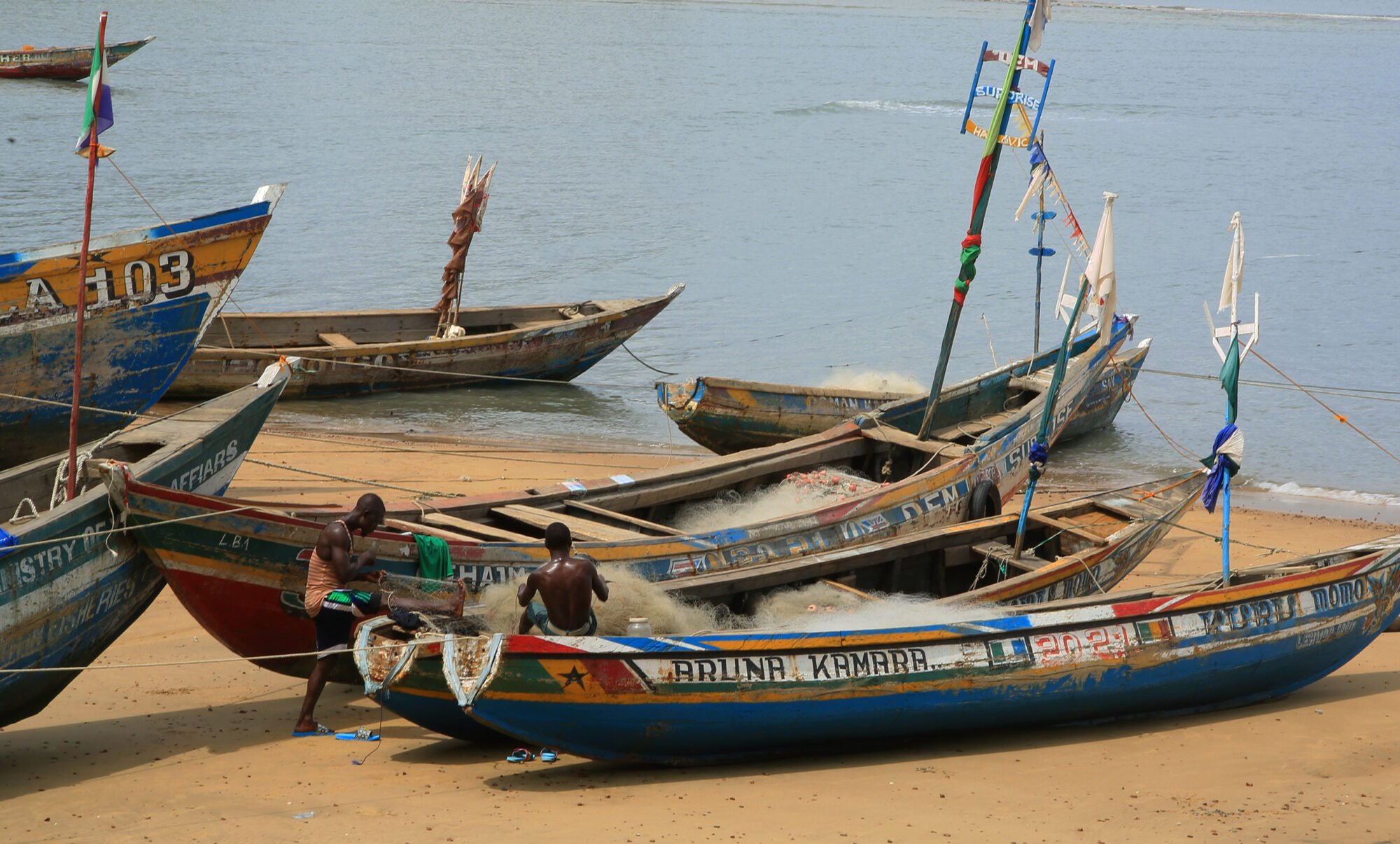
But Johnson from Fourah Bay College thinks more needs to be done. “Fishermen need more education to understand the changing pattern of the sea, and in the event of turbulence, they [need to be] able to communicate with one another or relevant institutions that are responsible for disaster management and search and rescue.”
Weather conditions have already become more severe in Sierra Leone. In 2017, intense rain caused flooding and landslides in Freetown that left more than 1,000 people dead. Having already experienced a roughly 0.8C rise in average temperature since the 1960s, the country is expected to see a further increase of 1.6C by 2100, according to a report by the government and the UN Development Programme.
Local action
Some communities are attempting to contain the rising sea themselves, using homemade methods such as sandbags. But in the town of Bonthe, which has an estimated 10,000 inhabitants, a publicly funded sea wall up to 1.7km long is being constructed. As Bonthe’s deputy mayor, Mohamed Robinson, explains though, it remains to be seen if the wall will be high enough to protect the town, even if the Paris Agreement’s target to limit global warming to 1.5C is met.
(Video: Saidu Bah / China Dialogue Ocean)
In addition to these local efforts, international players are also involved. In 2018, the Sierra Leonean government launched a project to promote “climate-resilient livelihoods” for 116,000 people – supported by the United Nations Development Programme, the project benefited from a US$9.9 million grant from the Global Environment Facility. The main aim was to diversify local economies and help communities restore mangrove habitats, making them more able to withstand the impacts of rising seas, extreme weather and an “uncertain climate future”.
Johnson has been a consultant on this umbrella project, implemented by government agencies, civil society and NGOs. He says one major success is the establishment of an oceanographic monitoring system that will help to improve the management of marine areas and resources, reduce pollution and provide proper predictions of tides and weather in Freetown and several other coastal locations.
Policies are not enough
As part of the UN’s climate change framework, Sierra Leone has developed a National Adaptation Plan, which sets out the actions needed to reduce the impacts of climate change nationally.
But there is concern over the implementation of these policies, according to Joseph Rahall, executive director of environmental NGO Green Scenery. “They should be translated into laws and the laws implemented,” he says. “Enforcement [is] the problem.”
Rahall wants the government to prioritise environmental issues by making them part of the national conversation through adequate budget allocation. “When you play with environmental safety, you’re playing with conflict. If those in government cannot mitigate the risks that come from climate change, that will cause hunger [and] diseases, and that will lead to instability.”

But with national action plans in place, acting director of Sierra Leone’s Ministry of the Environment, Edward Pieh Bendu, is confident the government is in a good position to respond to climate change. Over the next four years, for example, the government plans to reforest over 7,000 hectares of degraded land and mangrove swamp. The national project is expected to plant a total of five million trees – 1.1 million were already planted last year.
But with many coastal communities already suffering, Sierra Leone’s islanders need more urgent solutions to save both their homes and their livelihoods.
With additional reporting from Saidu Bah and Abdulai Kargbo.
